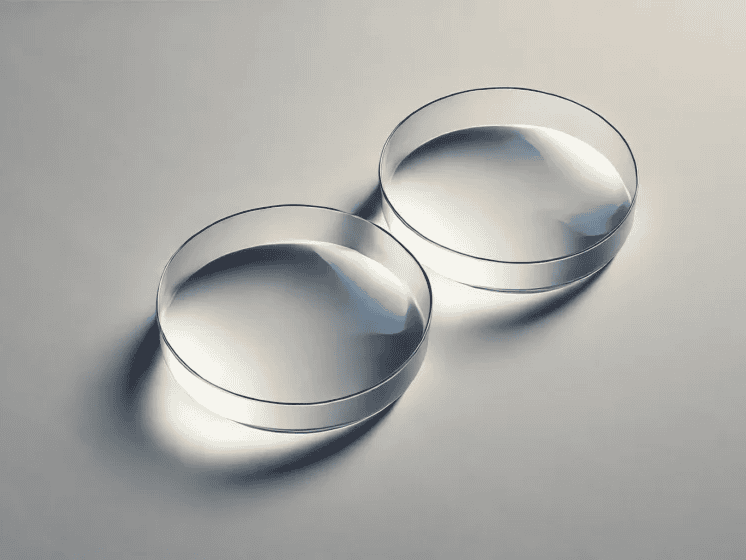When choosing a new pair of glasses, it’s helpful to understand the different lens coatings and treatments available. Lens coatings are applied to the surfaces of eyeglass lenses to enhance visual performance, comfort, and appearance. These enhancements can greatly improve the functionality, durability, and comfort of your eyewear.
Here are the different kinds of coatings and treatments you’ll come across:
- Anti-Reflective (AR) Coatings
- Scratch-Resistant Coatings
- UV Protective Coatings
- Photochromic Lenses
- Polarized Lenses
- Mirror Coatings
- Lens Tints
What Is an Anti-Reflective Coating?
An anti-reflective coating is a special layer applied to the surface of glasses and other optical devices to reduce glare and increase clarity. This coating is made by applying a very thin film of material onto the lens, which helps to minimize the amount of light that reflects off the surface. By doing this, it allows more light to pass through the lens, improving vision, especially in bright conditions or when working on screens.
The reason this coating works so well is that it is designed to counteract reflections by using layers that interfere with the light that bounces back. Each layer is scientifically crafted to enhance the passage of light at specific wavelengths, which makes the lens nearly invisible and reduces strain on the eyes. This makes activities like reading, driving at night, or using a computer much more comfortable by cutting down on the glare that can cause eye fatigue.
How Do Scratch-Resistant Coatings Work?
Scratch-resistant coatings protect lenses from everyday wear and tear. Applied during the manufacturing process, these coatings are not entirely scratch-proof but significantly enhance the durability of lenses.
This coating is effective because it forms a dense, strong protective layer that’s harder than the lens material itself, making the lenses more resistant to scratches from daily use. The coating is also transparent, so it doesn’t affect the clarity of the lenses, ensuring it doesn’t interfere with vision.It’s particularly beneficial for children’s glasses, or for anyone who uses their glasses in rough environments.
What Are UV Protective Coatings?
UV protective coatings on eyeglasses are specifically designed to block harmful ultraviolet rays from the sun. This is crucial for eye health as prolonged exposure to UV rays can lead to serious conditions such as cataracts and macular degeneration. By applying a UV protective coating to the lenses, glasses not only help improve vision clarity but also serve as an important barrier that shields the eyes from sun damage, much like sunscreen does for the skin.
In addition to health benefits, UV coatings on glasses enhance visual comfort by reducing glare. This is especially beneficial when you are outdoors or in bright environments, helping to prevent eye strain and discomfort. The coatings are invisible and do not change the appearance of the glasses, making them a practical choice for all types of eyewear, from prescription glasses to sunglasses.
Learn how UV rays affect your eyes and why UV Protection is so important for your glasses.
How Do Photochromic (Neochrome) Lenses Work?
Photochromic lenses, also known as Neochrome lenses are eyeglasses lenses that automatically adjust their tint when exposed to sunlight. The lenses contain special molecules that react to ultraviolet (UV) light. In indoor conditions or low light environments, these molecules remain inactive, which keeps the lenses clear. However, when you step outdoors into the sunlight, the UV rays trigger a chemical reaction, causing these molecules to change shape. This change in structure darkens the lens, effectively turning regular glasses into sunglasses.
This adaptive feature of photochromic lenses provides great convenience and protection. By automatically darkening in response to sunlight, these lenses help shield your eyes from harmful UV rays without the need to switch between regular glasses and sunglasses. They also offer continuous protection as the intensity of UV light changes throughout the day, ensuring comfort and improved visibility under varying light conditions. This makes them ideal for everyday wear, particularly for people who frequently move between indoors and outdoors.
If you’re interested in Neochrome lenses, read more about them here.
What Are Polarized Lenses and Their Benefits?
Polarized lenses are a type of eyewear coating designed to reduce glare from surfaces like water, roads, and snow. They work by using a special chemical film that is applied to the lens. This film contains molecules arranged in a specific pattern that blocks horizontal light waves, which are the type primarily responsible for glare. By filtering out these waves, polarized lenses allow only vertical light waves to pass through, significantly reducing blinding glare and improving visual clarity and contrast.
The benefits of wearing polarized lenses are particularly noticeable in situations where glare can be a problem, such as driving, fishing, skiing, or any outdoor activities. They help in reducing eye strain and providing a clearer view, which can make outdoor experiences more comfortable and safer.
If you’re picking out your next pair of sunglasses, it’s important to know the differences between polarized lenses and UV protective coatings.
What Are Mirror Coatings?
Mirror coatings on lenses are a type of optical coating applied to the outer surface of eyeglass lenses to give them a mirror-like appearance. This coating is made by applying a thin layer of metallic compounds onto the lens. The primary function of a mirror coating is to reflect light away from the lenses, reducing the amount of light that passes through. This makes them especially useful in very bright conditions, such as snow or water environments, where sunlight can be intense and cause discomfort or visual impairment.
The benefits of mirror coatings extend beyond just their light-blocking capabilities. They also provide an additional layer of privacy, as the coating makes it difficult for others to see the wearer’s eyes. Additionally, mirror coatings can enhance the aesthetic appeal of sunglasses, offering a variety of colors and finishes that can be tailored to personal style preferences.
What Is Lens Tinting and How Is It Applied?
Lens tinting involves adding a colored tint to eyeglass lenses, which not only enhances the visual appeal of the glasses but also serves practical purposes. The tint is applied during the manufacturing process by immersing the lenses in a special dye solution. The longer the lenses are left in the solution, the darker the tint becomes. This process allows for a variety of tint depths and colors, each serving different functions.
Green Tinted Lenses
Green lenses help to filter blue light, enhance contrast, and reduce glare and eye strain in bright sunlight. They are ideal for outdoor activities like golf or tennis and are also suitable for everyday use.
Blue or Purple Tinted Lenses
Lenses tinted in blue or purple enhance color perception and clarify the contours around objects. They are protective against reflections from surfaces like snow and are effective in foggy or misty conditions. Additionally, blue-tinted lenses are aesthetically pleasing and suit various skin tones.
Red or Rose Tinted Lenses
Red or rose lenses filter some blue light, enhancing driving visibility and eye comfort. They can improve depth perception and detail, making them suitable for sports like skiing.
Yellow, Orange, or Gold Tinted Lenses
Light-colored lenses such as yellow, orange, and gold are excellent in low-light conditions, offering improved depth perception and brightness. They are versatile for both outdoor and indoor sports but may alter color perception.
Gray Tinted Lenses
Gray lenses, known for their neutral color, are effective in reducing glare, particularly on water, making them excellent for fishing. They provide comfort on both cloudy and sunny days, offering anti-fatigue benefits, and are versatile for activities like driving.
Amber or Brown Tinted Lenses
These tints reduce glare and brighten cloudy days. They filter blue light and enhance depth perception, making them suitable for sports like golf or baseball. Amber lenses are also comfortable in sunny conditions and enhance contrast in green landscapes and blue skies.
When choosing your next pair of sunglasses, be sure to keep in mind the activities you’ll be using them for. Different lens coatings, tints, and treatments enhance the functionality and comfort of your sunglasses. Helping to tailor your lenses to meet your specific needs.
Discover independent eyewear with Project Spex. Every Friday, we deliver the latest in collectible eyewear and your favorite independent designers.
Sign up now and never miss a thing!
About The Author:

Will Benjamin is an advocate for independent eyewear and one of the driving forces behind Project Spex. With a passion for unique, collectible, and limited-edition eyewear, Will aims to inspire people to build their own collections through Project Spex, while supporting the success of independent opticals.


